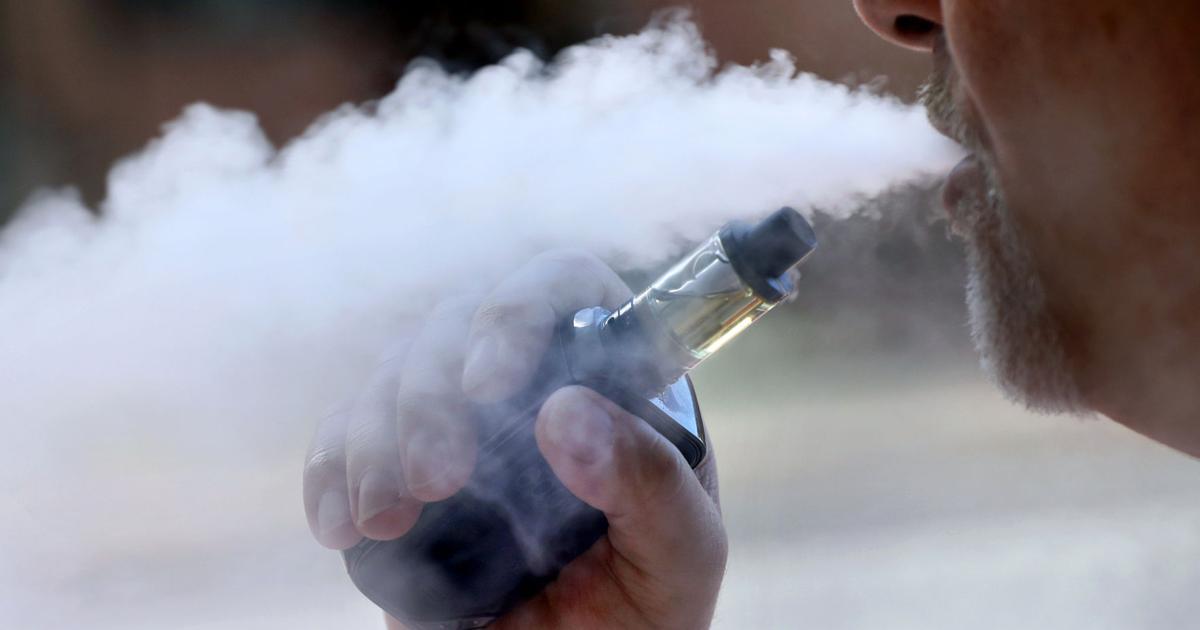Espa?ol (Spanish)

CDC, the U.S. Food and Drug Administration (FDA), state and local health departments, and other clinical and public health partners are investigating a national outbreak of e-cigarette, or vaping, product use associated lung injury (EVALI).
For the Public
For Healthcare Providers
For Health Departments
Resources
Digital Press Kit
On This Page
- What is New
- What We Know
- What We Don't Know
- What CDC Recommends
- Key Facts about E-Cigarette Use, or Vaping
- Key Facts about Vitamin E Acetate
- Latest Outbreak Information
- Map of Reported Cases
- Epi Chart of Reported Cases
- What CDC is Doing
calendar alt icon Updated December 5, 2019, at 1:00 PM EST
What is New
CDC has identified vitamin E acetate as a chemical of concern among people with e-cigarette, or vaping, product use associated lung injury (EVALI). Recent CDC laboratory testing of bronchoalveolar lavage (BAL) fluid samples (fluid samples collected from the lungs) from 29 patients with EVALI submitted to CDC from 10 states found vitamin E acetate in all of the samples. Vitamin E acetate is used as an additive, most notably as a thickening agent in THC-containing e-cigarette, or vaping, products.
CDC recommends that people should not use THC-containing e-cigarette, or vaping, products, particularly from informal sources like friends, or family, or in-person or online dealers. In addition, people should not add any substance to e-cigarette or vaping products that are not intended by the manufacturer, including products purchased through retail establishments.
While this investigation is ongoing, vitamin E acetate should not be added to e-cigarette, or vaping, products. CDC will continue to update guidance, as appropriate, as new data become available from this complex outbreak.
What We Know
New Laboratory Findings:
- Analyses of bronchoalveolar lavage (BAL) fluid samples (fluid samples collected from the lungs) of patients with e-cigarette, or vaping, product use associated lung injury (EVALI) identified vitamin E acetate, an additive in some THC-containing e-cigarette, or vaping, products.
- Recent CDC laboratory test results of BAL fluid samples from 29 patients submitted to CDC from 10 states found vitamin E acetate in all of the samples.
- THC was identified in 82% of the samples and nicotine was identified in 62% of the samples.
- CDC tested for a range of other chemicals that might be found in e-cigarette, or vaping, products, including plant oils, petroleum distillates like mineral oil, MCT oil, and terpenes (which are compounds found in or added to THC products). None of these chemicals of concern were detected in the BAL fluid samples tested.
- This is the first time that we have detected a chemical of concern in biologic samples from patients with these lung injuries. These findings provide direct evidence of vitamin E acetate at the primary site of injury within the lungs.
- These findings complement the ongoing work of FDAexternal icon and some state public health laboratories to characterize e-liquid exposures and inform the ongoing national outbreak.
About the Outbreak:
- The EVALI cases and EVALI deaths reported as of December 4, 2019, include data from a two-week period, November 17th to November 30th.
- As of December 4, 2019, 2,291* cases of hospitalized e-cigarette, or vaping, product use associated lung injury (EVALI) have been reported to CDC from 50 states, the District of Columbia, and 2 U.S. territories (Puerto Rico and U.S. Virgin Islands).
- Forty-eight deaths have been confirmed in 25 states and the District of Columbia (as of December 4, 2019).
- As of December 4, 2019, CDC will only report hospitalized EVALI cases and EVALI deaths regardless of hospitalization status. CDC has removed* nonhospitalized cases from previously reported cases counts. See Public Health Reporting for more information.
- CDC continues to work closely with FDA, states, public health partners, and clinicians on this investigation.
About Patient Exposure:
- All EVALI patients have reported a history of using e-cigarette, or vaping, products.
- Vitamin E acetate has been identified as a chemical of concern among people with e-cigarette, or vaping, product use associated lung injury (EVALI).
- THC is present in most of the samples tested by FDA to date, and most patients report a history of using THC-containing e-cigarette, or vaping, products.
- The latest national and state findings suggest THC-containing e-cigarette, or vaping, products, particularly from informal sources like friends, or family, or in-person or online dealers, are linked to most of the cases and play a major role in the outbreak.
* Due to only reporting hospitalized EVALI cases as of December 4, 2019, CDC removed 175 nonhospitalized cases from previously reported national case counts.
What We Don't Know
- While it appears that vitamin E acetate is associated with EVALI, evidence is not yet sufficient to rule out contribution of other chemicals of concern.
- Many different substances and product sources are still under investigation, and it may be that there is more than one cause of this outbreak.
What CDC Recommends
- CDC recommends that people do not use THC-containing e-cigarette, or vaping, products.
- CDC also recommends that people should not:
- Buy any type of e-cigarette, or vaping, products, particularly those containing THC from informal sources like friends, or family, or in-person or online dealers.
- Modify or add any substances to e-cigarette, or vaping, products that are not intended by the manufacturer, including products purchased through retail establishments.
- While it appears that vitamin E acetate is associated with EVALI, evidence is not yet sufficient to rule out contribution of other chemicals of concern.
- Many different substances and product sources are still under investigation, and it may be that there is more than one cause of this outbreak.
- The only way to assure that you are not at risk while the investigation continues is to consider refraining from use of all e-cigarette, or vaping, products.
- Adults using e-cigarettes to quit smoking should not go back to smoking; they should weigh all risks and benefits and consider utilizing FDA approved cessation medicationsexternal icon. Contact your healthcare provider if you need help quitting tobacco products, including e-cigarettes.
- Adults who continue to use an e-cigarette, or vaping, product, should carefully monitor themselves for symptoms and see a healthcare provider immediately if they develop symptoms like those reported in this outbreak.
- Adults with ongoing problematic marijuana use should seek out evidence-based behavioral treatment. As appropriate, they should also seek treatment for any other co-occurring substance misuse or abuse problems or related health conditions.
- A number of therapy-based treatments such as cognitive-behavioral therapy, contingency management, motivational enhancement therapy, and multi-dimensional family therapy have been shown to help people who are have problematic marijuana use that lead to significant impairment or distress.
- Visit Substance Abuse and Mental Health Services Administration’s Treatment Locatorexternal icon to locate treatment in your area or call 1-800-662-HELP (4357).
- Regardless of the ongoing investigation:
- E-cigarette, or vaping, products should never be used by youths, young adults, or women who are pregnant.
- Adults who do not currently use tobacco products should not start using e-cigarette, or vaping, products. There is no safe tobacco product. All tobacco products, including e-cigarettes, carry a risk.
- THC use has been associated with a wide range of health effects, particularly with prolonged frequent use. The best way to avoid potentially harmful effects is to not use THC-containing e-cigarette, or vaping, products. Persons with ongoing problematic marijuana use that causes significant impairment or distress should seek evidence-based treatment by a health care provider.
- People who have significant impairment or distress from ongoing problematic use of THC-containing e-cigarette, or vaping, products should seek evidence-based behavioral treatment and recovery services.
Top of Page
Key Facts about Use of E-Cigarette, or Vaping, Products
- Electronic cigarettes — or e-cigarettes — are also called vapes, e-hookahs, vape pens, tank systems, mods, and electronic nicotine delivery systems (ENDS).
- Using an e-cigarette is commonly called vaping.
- E-cigarettes work by heating a liquid to produce an aerosol that users inhale into their lungs.
- The liquid can contain: nicotine, tetrahydrocannabinol (THC) and cannabinoid (CBD) oils, and other substances and additives. THC is the psychoactive mind-altering compound of marijuana that produces the “high”.
Key Facts about Vitamin E Acetate
- Vitamin E acetate is used as an additive, most notably as a thickening agent in THC-containing e-cigarette, or vaping, products.
- Vitamin E is a vitamin found in many foods, including vegetable oils, cereals, meat, fruits, and vegetables. It is also available as a dietary supplement and in many cosmetic products, like skin creams.
- Vitamin E acetate usually does not cause harm when ingested as a vitamin supplement or applied to the skin. However, previous research suggests when vitamin E acetate is inhaled, it may interfere with normal lung functioning.
If you have questions about CDC’s investigation into the lung injuries associated with use of e-cigarette, or vaping, products, contact CDC-INFO or call 1-800-232-4636.
Latest Outbreak Information
- This complex investigation spans almost all states, involves over 2,000 patients, and a wide variety of brands and substances and e-cigarette, or vaping, products.
- As of December 4, 2019, 2,291* cases of hospitalized e-cigarette, or vaping, product use associated lung injury (EVALI) have been reported to CDC from 50 states, the District of Columbia, and 2 U.S. territories (Puerto Rico and U.S. Virgin Islands).
- Forty-eight deaths have been confirmed in 25 states and the District of Columbia (as of December 4, 2019):
- Alabama, California, Connecticut, Delaware, District of Columbia, Florida, Georgia, Illinois, Indiana, Kansas, Louisiana, Massachusetts, Michigan, Minnesota, Mississippi, Missouri, Montana, Nebraska, New Jersey, New York, Oregon, Pennsylvania, Tennessee, Texas, Utah, and Virginia
- The median age of deceased patients was 52 years and ranged from 17 to 75 years (as of December 4, 2019).
- More deaths are under investigation.
- The EVALI cases and EVALI deaths reported as of December 4, 2019, include data from a two-week period, November 17th to November 30th.
- As of December 4, 2019, CDC will only report hospitalized EVALI cases and EVALI deaths regardless of hospitalization status. CDC has removed* nonhospitalized cases from previously reported cases counts.
- Among the 2,016 cases of e-cigarette, or vaping, product use associated lung injury (EVALI) reported to CDC with available data on hospitalization status (as of November 5, 2019):
- 95% were hospitalized, and 5% were not hospitalized.
- 68% were male (among 1,905 patients with data on sex)
- 77% were under 35 years old, with a median age of 24 years and age range from 13 to 78 years (among 1,906 patients with data on age)
- By age group category:
- 15% of patients were under 18 years old;
- 38% of patients were 18 to 24 years old;
- 24% of patients were 25 to 34 years old; and
- 23% of patients were 35 years or older.
- 1,184 patients had complete information** on substances used in e-cigarette, or vaping, products in the 3 months prior to symptom onset, of whom (as of November 5, 2019):
- 83% reported using THC-containing products; 35% reported exclusive use of THC-containing products.
- 61% reported using nicotine-containing products; 13% reported exclusive use of nicotine-containing products.
- 48% reported both THC- and nicotine-containing product use.
- 4% reported no THC- or nicotine-containing product use.
* Due to only reporting hospitalized EVALI cases as of December 4, 2019, CDC removed 175 nonhospitalized cases from previously reported national case counts.
** Based on complete reports received.
Number of Lung Injury Cases Reported to CDC as of December 3, 2019
Dates of symptom onset and hospital admission for patients with lung injury associated with e-cigarette use, or vaping — United States, March 31–November 30, 2019
Top of Page
What CDC is Doing
Public Health Response:
- CDC’s Lung Injury response efforts are committed to:
- Identify and define the risk factors and the source for lung disease associated with e-cigarette product use, or vaping.
- Detect and track confirmed and probable cases in the US.
- Communicate actionable recommendations to state, local, and clinical audiences.
- Establish lab procedures that can assist with the public heath investigation and patient care.
Partnerships:
- CDC is working 24/7 to identify the cause or causes of this outbreak.
- CDC continues to work closely with FDA, states, public health partners, and clinicians on this investigation by providing consultation and technical assistance to states on communication, health alerts, public outreach, and surveillance.
- CDC has activated the Emergency Operations Center (EOC) to coordinate activities and provide assistance to states, public health partners and clinicians around the nation.
- CDC worked with states to create case definitions to classify confirmed and probable cases in a consistent way. States are in the process of classifying patients.
- CDC will report numbers of confirmed and probable lung injury cases once states have finalized their classification of cases.
- By invitation, CDC has deployed Epidemic Intelligence Service (EIS) officers and other CDC staff to support states.
- CDC has been communicating with international public health partners. Currently, there is a very small number of similar lung injuries outside the U.S. and not close to the magnitude in the U.S.
Media and Communication:
- CDC is maintaining an outbreak webpage with key messages and weekly updates on case counts, deaths, and resources available to healthcare providers, health departments, and the public.
- CDC is holding congressional briefings, media telebriefings, and regular calls with health departments, clinicians to provide timely updates.
Laboratory Testing:
- CDC is currently testing bronchoalveolar lavage (BAL) fluid samples as well as blood or urine samples paired to BAL fluid samples.
- CDC is testing pathologic specimens, including lung biopsy or autopsy specimens, associated with patients.
- CDC is offering aerosol emission testing of case-associated product samples from e-cigarette, or vaping, products, and e-liquids. For more information about submission, see Product Sample Submission Information.
- Results can help provide insight into the nature of chemical exposure(s) contributing to this outbreak.
- CDC developed guidance documents to assist public health laboratories, healthcare providers, pathologists, and others with specimen collection, storage, and submission to CDC for testing.
- For more information and resources visit For the Public, For Healthcare Providers and For State and Local Health Departments as well as our Publications and Resources page.









Leave a comment: